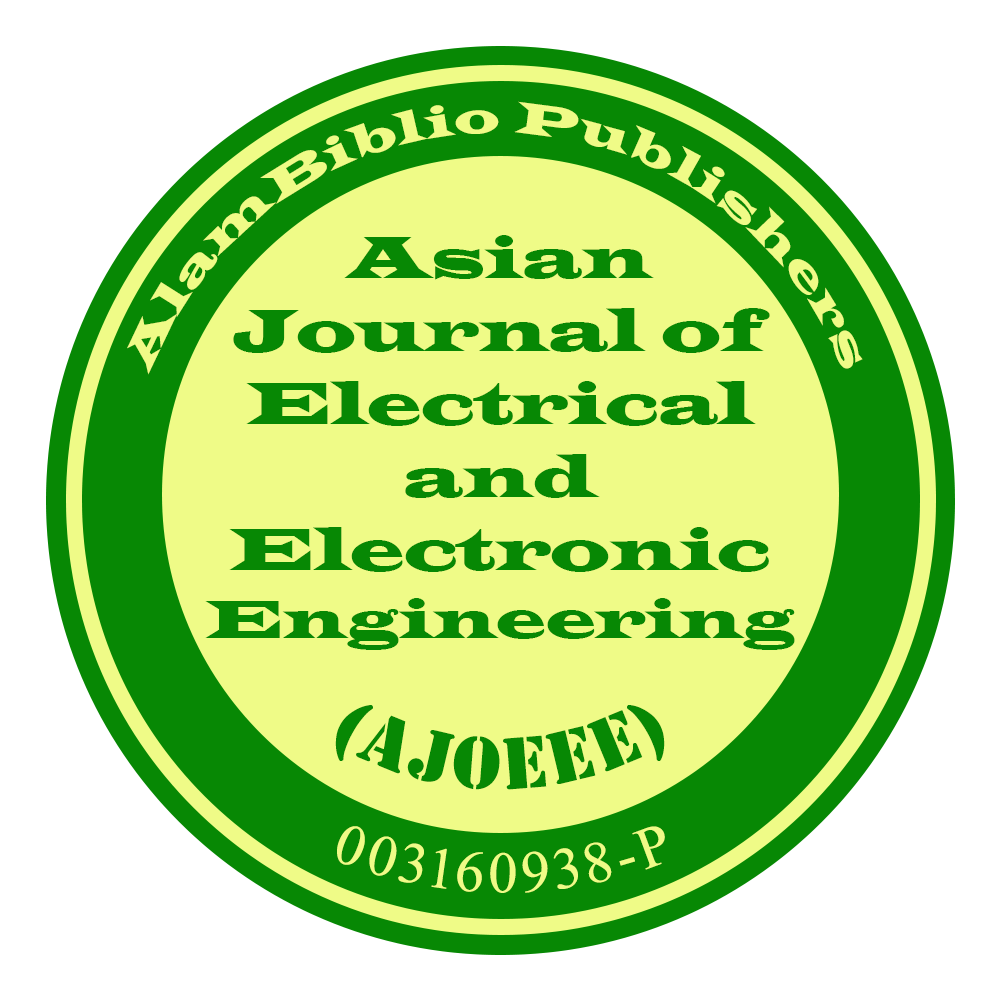Improving Rotational Stability and Enhancing Efficiency with Variable Inertial Flywheels and Magneto-rheological Fluids
DOI:
https://doi.org/10.69955/ajoeee.2024.v4i1.56Keywords:
VIF, Semi-active control, Energy Saving, Inertia ControlAbstract
Variations in the rotational speed of a flywheel are naturally resisted by the moment of inertia. A high moment of inertia must be maintained to minimize angular velocity variations. Conversely, a significant moment of inertia makes it difficult to start spinning machines. A flywheel with a variable moment of inertia has been suggested to solve this issue. Although fluctuations between the masses' radii across the flywheel's axis may be used to approximate true inertia, the variable inertial flywheel's (VIF) control mechanisms are somewhat complex. Magneto-rheological (MR) Fluids can be utilized to avoid the complexity of the VIF. The applied device parameters determine the design and construction of the VIF system using a relatively simple control technique. To determine the relation between the semi-active VIF control system and the input parameters of a rotating electrical machine to decrease energy losses, adequate data from a VIF coupled with an induction motor (IM) system is gathered in this study. An analysis was done on the system, and the outcome showed a possible improvement in the performance of IM. This study significantly reduces power consumption and smooth speed build-up possibility for the proposed system.
Downloads
References
[1] O. Farhadi, M., Mohammed, "Energy storage technologies for high power applications," IEEE Trans. Ind. Appl, vol. 52, no. 3, pp. 1953-1961, 2016. https://doi.org/10.1109/TIA.2015.2511096 DOI: https://doi.org/10.1109/TIA.2015.2511096
[2] A. Lazarewicz, M.L., Rojas, "Grid frequency regulation by recycling electrical energy in flywheels," Power Eng. Soc. Gen. Meet., vol. 2, pp. 2038-2042, 2004. https://doi.org/10.1109/PES.2004.1373235 DOI: https://doi.org/10.1109/PES.2004.1373235
[3] J. A. Kirk, "Flywheel energy storage-I," Int. J. Mech. Sci., vol. 19, no. 4, pp. 223-231, Jan. 1977, doi: 10.1016/0020-7403(77)90064-9. https://doi.org/10.1016/0020-7403(77)90064-9 DOI: https://doi.org/10.1016/0020-7403(77)90064-9
[4] V. Kartašovas, V. Barzdaitis, and P. Mažeika, "Modeling and simulation of variable inertia rotor," J. Vibroengineering, vol. 14, no. 4, pp. 1745-1750, 2012.
[5] G. Zhong, Q.C.;Weiss, "Synchonverter: Inverters that mimic synchronous generators," IEEE Trans. Ind. Electron, vol. 58, pp. 1259-1265, 2011. https://doi.org/10.1109/TIE.2010.2048839 DOI: https://doi.org/10.1109/TIE.2010.2048839
[6] C. Jauch, "Controls of a Flywheel in a Wind Turbine Rotor," Wind Eng. 2016, vol. 40, pp. 173-185. https://doi.org/10.1177/0309524X16641577 DOI: https://doi.org/10.1177/0309524X16641577
[7] Figliotti MP and Gomes MW, "A variable-inertia flywheel model for regenerative braking on a bicycle," ASME 2014 Dyn. Syst. Control Conf. San Antonio, New York Am. Soc. Mech. Eng. https://doi.org/10.1115/DSCC2014-6276 DOI: https://doi.org/10.1115/DSCC2014-6276
[8] V. de V. J. Fluidic, "variable inertia flywheel.," 7th Int. energy Convers. Eng. Conf. Denver, CO, 2-5 August 2009, Pap. no. AIAA2009- 4501. Reston, VA Am. Inst. Aeronaut. Astronaut.
[9] U. M. Ishida Y I T, Fukami T, "Torsional vibration suppression by roller type centrifugal vibration absorbers," J. Vib. Acoust. 131, pp. 1-10, 2009. https://doi.org/10.1115/1.3147124 DOI: https://doi.org/10.1115/1.3147124
[10] J. V. D. V, "Fluidic variable inertia flywheel and flywheel accumulator system," 2012.
[11] Z. F. M. and X. G. X. Yuan L G, "Research on the design and control strategy of variable inertia flywheel in diesel generator unit under pulsed load," Int. Conf. Comput. Control Ind. Eng. 187-9, 2010.
[12] H. H. Y. and L. D. Y. Bao E, "The theory and synthesis of high effect flywheel with variable equivalent mass moment of inertia," Adv. Mater. Res. 199-200 225-31, 2011. https://doi.org/10.4028/www.scientific.net/AMR.199-200.225 DOI: https://doi.org/10.4028/www.scientific.net/AMR.199-200.225
[13] M. T, "Vibration suppression device having variable inertia mass by MR-fluid," ASME 2011 Int. Des. Eng. Tech. Conf. Comput. Inf. Eng. Conf. 1181-5, 2011.
[14] D. J. Inman, Engineering Vibration, Internatio. Prentice-Hall International, Inc, 1994.
[15] Y. Liu, "Semi-active damping control for vibration isolation of base disturbances," Diss. Univ. Southampt., 2004.
[16] M. Trikande, N. Karve, R. Anand Raj, V. Jagirdar, and R. Vasudevan, "Semi-active vibration control of an 8x8 armored wheeled platform," J. Vib. Control, vol. 24, no. 2, pp. 283-302, Jan. 2018, doi: 10.1177/1077546316638199. https://doi.org/10.1177/1077546316638199 DOI: https://doi.org/10.1177/1077546316638199
[17] N. Eslaminasab, "Development of a Semi-active Intelligent Suspension System for Heavy Vehicles," p. 181, 2008.
[18] A. C. Mahato, S. K. Ghoshal, and A. K. Samantaray, "Influence of variable inertia flywheel and soft switching on a power hydraulic system," SN Appl. Sci., vol. 1, no. 6, p. 605, Jun. 2019, doi: 10.1007/s42452-019-0623-0. https://doi.org/10.1007/s42452-019-0623-0 DOI: https://doi.org/10.1007/s42452-019-0623-0
[19] J. Braid, "Conceptual design of a liquid-based variable inertia flywheel for microgrid applications," ENERGYCON 2014 - IEEE Int. Energy Conf., no. 2, pp. 1291-1296, 2014, doi: 10.1109/ENERGYCON.2014.6850589. https://doi.org/10.1109/ENERGYCON.2014.6850589 DOI: https://doi.org/10.1109/ENERGYCON.2014.6850589
[20] X. Dong, J. Xi, P. Chen, and W. Li, "Magneto-rheological variable inertia flywheel," Smart Mater. Struct., vol. 27, no. 11, p. 115015, Nov. 2018, doi: 10.1088/1361-665X/aad42b. https://doi.org/10.1088/1361-665X/aad42b DOI: https://doi.org/10.1088/1361-665X/aad42b
[21] S. M. Salam and M. M. Rashid, "A new approach to analysis and simulation of flywheel energy storage system," in 8th International Conference on Mechatronics Engineering (ICOM 2022), 2022, pp. 90-94, doi: 10.1049/icp.2022.2271. https://doi.org/10.1049/icp.2022.2271 DOI: https://doi.org/10.1049/icp.2022.2271
[22] L. Islam, M. M. Rashid, and M. A. Faysal, "Investigation of the Energy Saving Capability of a Variable Inertia Magneto-Rheological ( MR ) Flywheel," vol. 2, no. 1, pp. 25-31, 2022. https://doi.org/10.69955/ajoeee.2022.v2i1.30 DOI: https://doi.org/10.69955/ajoeee.2022.v2i1.30
[23] J. D. Carlson and M. R. Jolly, "MR fluid, foam and elastomer devices," Mechatronics, vol. 10, no. 4, pp. 555-569, 2000, doi: 10.1016/S0957-4158(99)00064-1. https://doi.org/10.1016/S0957-4158(99)00064-1 DOI: https://doi.org/10.1016/S0957-4158(99)00064-1
[24] M. J. Wilson, A. Fuchs, and F. Gordaninejad, "Development and characterization of magnetorheological polymer gels," J. Appl. Polym. Sci., vol. 84, no. 14, pp. 2733-2742, 2002, doi: 10.1002/app.10525. https://doi.org/10.1002/app.10525 DOI: https://doi.org/10.1002/app.10525
[25] X. H. Liu, P. L. Wong, W. Wang, and W. A. Bullough, "Feasibility study on the storage of magnetorheological fluid using metal foams," J. Intell. Mater. Syst. Struct., vol. 21, no. 12, pp. 1193-1200, 2010, doi: 10.1177/1045389X10382585. https://doi.org/10.1177/1045389X10382585 DOI: https://doi.org/10.1177/1045389X10382585
[26] E. J. R. Hardy, "The magnetic fluid clutch," Students Q. J., vol. 22, no. 86, p. 51, 1951, doi: 10.1049/sqj.1951.0064. https://doi.org/10.1049/sqj.1951.0064 DOI: https://doi.org/10.1049/sqj.1951.0064
[27] W. Lu, Y. Luo, L. L. Kang, and D. Wei, "Characteristics of magnetorheological fluids under new formulation," J. Test. Eval., vol. 47, no. 4, 2019, doi: 10.1520/JTE20170477. https://doi.org/10.1520/JTE20170477 DOI: https://doi.org/10.1520/JTE20170477
[28] A. G. Olabi and A. Grunwald, "Design and application of magneto-rheological fluid," Mater. Des., vol. 28, no. 10, pp. 2658-2664, 2007, doi: 10.1016/j.matdes.2006.10.009. https://doi.org/10.1016/j.matdes.2006.10.009 DOI: https://doi.org/10.1016/j.matdes.2006.10.009
Downloads
Published
Issue
Section
License
Copyright (c) 2024 AlamBiblilo Publishers

This work is licensed under a Creative Commons Attribution-NonCommercial 4.0 International License.
The Asian Journal of Electrical and Electronic Engineering journal is licensed under a Creative Commons Attribution-NonCommercial 4.0 International License.










